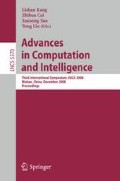Abstract
Traditional technology of lithology identification bases on statistical theory, such as regression method and cluster method, which has some shortcomings. The standard BP neural network algorithm has some disadvantages like slow convergence speed, local minimum value which results in the loss of global optimal solution. BP neural network algorithm on the basis of improved variable rate of momentum factor can effectively overcome these disadvantages. Practical application shows that this method has the feature as high recognition precision and fast recognition rate so that it is suitable for recognition of lithology, lithofacies and sedimentary facies as well as geological research like deposit prediction and rock and mineral recognition.
Access this chapter
Tax calculation will be finalised at checkout
Purchases are for personal use only
Preview
Unable to display preview. Download preview PDF.
References
Cheng, G., Zhou, G., Wang, X.: The Probability Neural Networks for Lithology Identification. Control & Automation 23(6), 288–290 (2007)
Chen, R.: Research on the Application of BP Neural Networks. Control & Automation 23(8), 258–259 (2007)
Zhou, G., Cheng, G.: BRF neural networks for petroleum reservoir characterization. Computer Engineering and Applications 43(8), 174–176 (2007)
Zhou, B., Li, Z., Pan, B.: A Study on Lithology Identification Methods for Volcanic Rocks. Journal of Jilin University (Earth Science Edition) 35(3), 394–397 (2005)
Zhang, H., Zou, L., Shen, X.: The Application of BP Neural Network in Well Lithology Identification. Geology and Prospection 38(6), 63–65 (2002)
Xie, L.: BP Neural Network Algorithm Improvements and Convergence Analysis. Computing Technology and Automation 26(3), 52–56 (2007)
Hopfield, J.J.: Neural Networks and Physical Systems with Emergent Collective Computational Abilities. Proc. Nat. Acad. Sci. (79), 554–558 (1982)
Dony, R.D., Simon: Neural Network Approaches to Image Compression. Proceedings of the IEEE 83, 288–303 (1995)
Fritzke, B.: Growing cell structure – A self-organizing neural network for unsupervised and supervised learning. Neural Networks 7, 441–460 (1994)
Yarlagadda, P.K.D.V., Chiang, E.C.W.: A neural network system for the prediction of process parameters in pressure die casting. Mater. Proc. Technol. 89-90, 583–590 (1999)
Author information
Authors and Affiliations
Editor information
Editors and Affiliations
Rights and permissions
Copyright information
© 2008 Springer-Verlag Berlin Heidelberg
About this paper
Cite this paper
Shao, Y., Chen, Q., Zhang, D. (2008). The Application of Improved BP Neural Network Algorithm in Lithology Recognition. In: Kang, L., Cai, Z., Yan, X., Liu, Y. (eds) Advances in Computation and Intelligence. ISICA 2008. Lecture Notes in Computer Science, vol 5370. Springer, Berlin, Heidelberg. https://doi.org/10.1007/978-3-540-92137-0_38
Download citation
DOI: https://doi.org/10.1007/978-3-540-92137-0_38
Publisher Name: Springer, Berlin, Heidelberg
Print ISBN: 978-3-540-92136-3
Online ISBN: 978-3-540-92137-0
eBook Packages: Computer ScienceComputer Science (R0)

